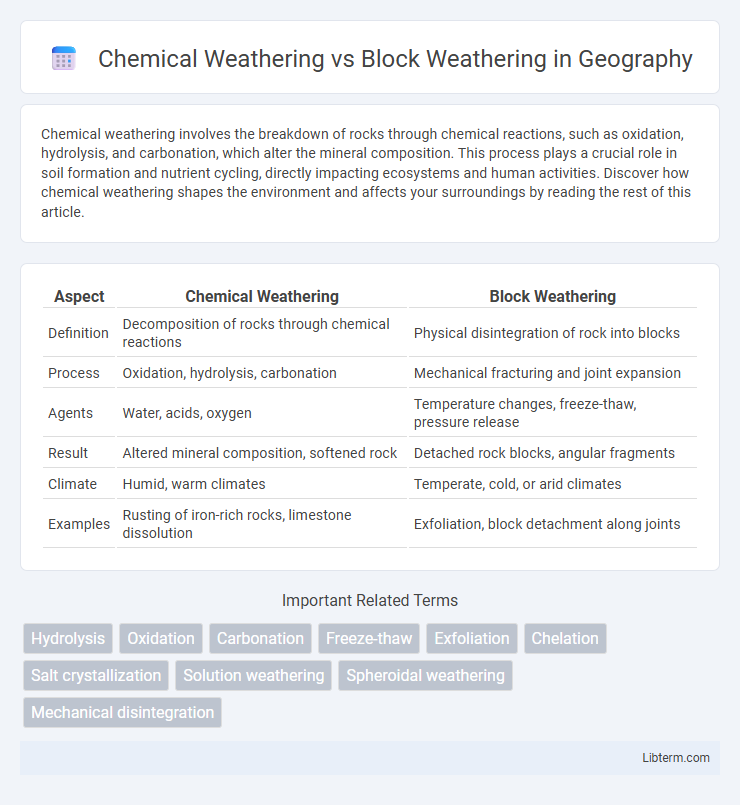Chemical weathering involves the breakdown of rocks through chemical reactions, such as oxidation, hydrolysis, and carbonation, which alter the mineral composition. This process plays a crucial role in soil formation and nutrient cycling, directly impacting ecosystems and human activities. Discover how chemical weathering shapes the environment and affects your surroundings by reading the rest of this article.
Table of Comparison
| Aspect | Chemical Weathering | Block Weathering |
|---|---|---|
| Definition | Decomposition of rocks through chemical reactions | Physical disintegration of rock into blocks |
| Process | Oxidation, hydrolysis, carbonation | Mechanical fracturing and joint expansion |
| Agents | Water, acids, oxygen | Temperature changes, freeze-thaw, pressure release |
| Result | Altered mineral composition, softened rock | Detached rock blocks, angular fragments |
| Climate | Humid, warm climates | Temperate, cold, or arid climates |
| Examples | Rusting of iron-rich rocks, limestone dissolution | Exfoliation, block detachment along joints |
Introduction to Weathering Processes
Weathering processes break down rocks through distinct mechanisms, with chemical weathering involving the alteration of minerals via chemical reactions such as hydrolysis, oxidation, and dissolution. In contrast, block weathering primarily results from physical disintegration due to mechanical stresses like freeze-thaw cycles and thermal expansion, leading to the separation of rock into blocks or fragments. Understanding these processes is crucial for analyzing landscape evolution, soil formation, and rock decay in various environmental conditions.
Defining Chemical Weathering
Chemical weathering involves the breakdown of rocks through chemical reactions, such as hydrolysis, oxidation, and dissolution, altering the mineral composition and structure. Unlike block weathering, which physically fragments rock into blocks along joints and fractures, chemical weathering transforms minerals at the molecular level, often resulting in soil formation. Key minerals affected by chemical weathering include feldspar, which converts into clay minerals through hydrolysis, a primary process in this type of weathering.
Understanding Block Weathering
Block weathering is a physical process where large, angular rock blocks detach from a parent rock mass due to mechanical stress and temperature fluctuations, often in jointed rock formations. Unlike chemical weathering that alters mineral composition via reactions with water and atmospheric gases, block weathering preserves the mineral integrity while causing physical fragmentation. This process is significant in shaping landscapes by producing distinct blocky debris and influencing erosion patterns in environments with pronounced thermal cycling or freeze-thaw cycles.
Key Differences Between Chemical and Block Weathering
Chemical weathering involves the breakdown of minerals through chemical reactions such as oxidation, hydrolysis, and carbonation, altering the rock's chemical composition. Block weathering, a physical process, causes large rock masses to fracture into angular blocks due to mechanical stresses like temperature fluctuations and freeze-thaw cycles. Unlike chemical weathering, block weathering does not change the rock's mineralogy but changes its physical structure by creating jointed blocks.
Mechanisms of Chemical Weathering
Chemical weathering involves the breakdown of rocks through chemical reactions such as hydrolysis, oxidation, and carbonation, which alter the mineral composition and structure of the rock. Water acts as a primary agent, facilitating reactions that dissolve or transform minerals like feldspar into clay minerals. In contrast, block weathering is primarily a physical process characterized by rock fracturing along joints and faults without significant chemical alteration.
Factors Influencing Block Weathering
Block weathering is primarily influenced by factors such as rock joint patterns, bedrock composition, and climate conditions like temperature and moisture. The presence of fractures and weaknesses in the rock promotes physical breakdown, while environmental elements like rainfall and freeze-thaw cycles accelerate the disintegration process. These factors collectively determine the rate and extent of block weathering compared to chemical weathering, which involves mineral decomposition through chemical reactions.
Geological Examples of Chemical Weathering
Chemical weathering occurs when minerals in rocks chemically react with water, oxygen, or acids, leading to the decomposition of the rock's original minerals, as seen in the formation of clay from feldspar in granite landscapes like the Sierra Nevada. Block weathering, often physical, involves the mechanical breakdown of large rock masses into smaller blocks without significant chemical alteration, common in granite outcrops exposed to freeze-thaw cycles. Examples of chemical weathering in geology include karst landscapes formed by limestone dissolution and the rusting of iron-rich rocks producing reddish soils in tropical regions.
Case Studies of Block Weathering
Block weathering primarily involves the physical breakdown of rock into distinct blocks along natural fractures, as demonstrated in the granite tors of Dartmoor, UK, where repeated freeze-thaw cycles and temperature fluctuations create characteristic block formations. In the Sierra Nevada, California, jointed granite slabs undergo block weathering, influenced by exfoliation and unloading processes, leading to the detachment of large blocks that shape the landscape. These case studies highlight block weathering as a mechanical process contrasting with chemical weathering, which alters rock mineralogy through reactions such as hydrolysis and oxidation.
Environmental Impacts of Each Weathering Type
Chemical weathering significantly alters soil chemistry by breaking down minerals into soluble ions, which can lead to nutrient depletion and affect plant growth in ecosystems. Block weathering physically fragments rocks into smaller blocks without changing their chemical composition, influencing landscape stability and increasing sediment transport in rivers. Both processes contribute to soil formation, but chemical weathering has a more direct impact on nutrient cycles, while block weathering primarily affects mechanical erosion and habitat changes.
Conclusion: Chemical Weathering vs Block Weathering
Chemical weathering alters rock composition through chemical reactions, leading to mineral breakdown and soil formation, whereas block weathering primarily involves the physical disintegration of rock into angular fragments without significant chemical change. The rate of chemical weathering depends on factors such as temperature, moisture, and rock mineralogy, while block weathering is influenced by mechanical forces like freeze-thaw cycles and pressure release. Understanding these processes is essential for predicting landscape evolution, soil development, and managing erosion in different climatic and geological settings.
Chemical Weathering Infographic

 libterm.com
libterm.com